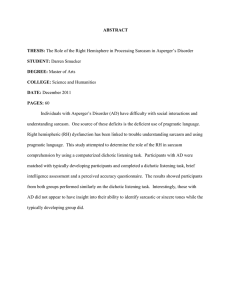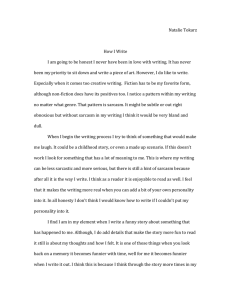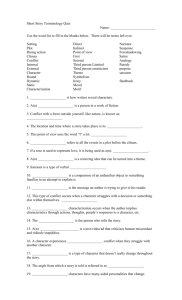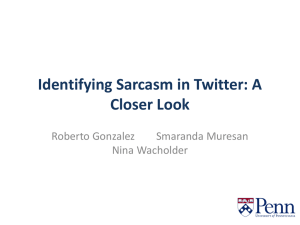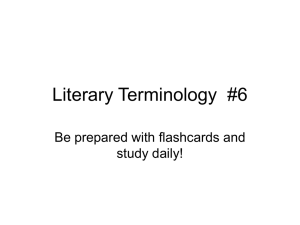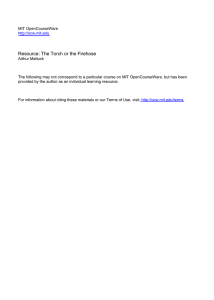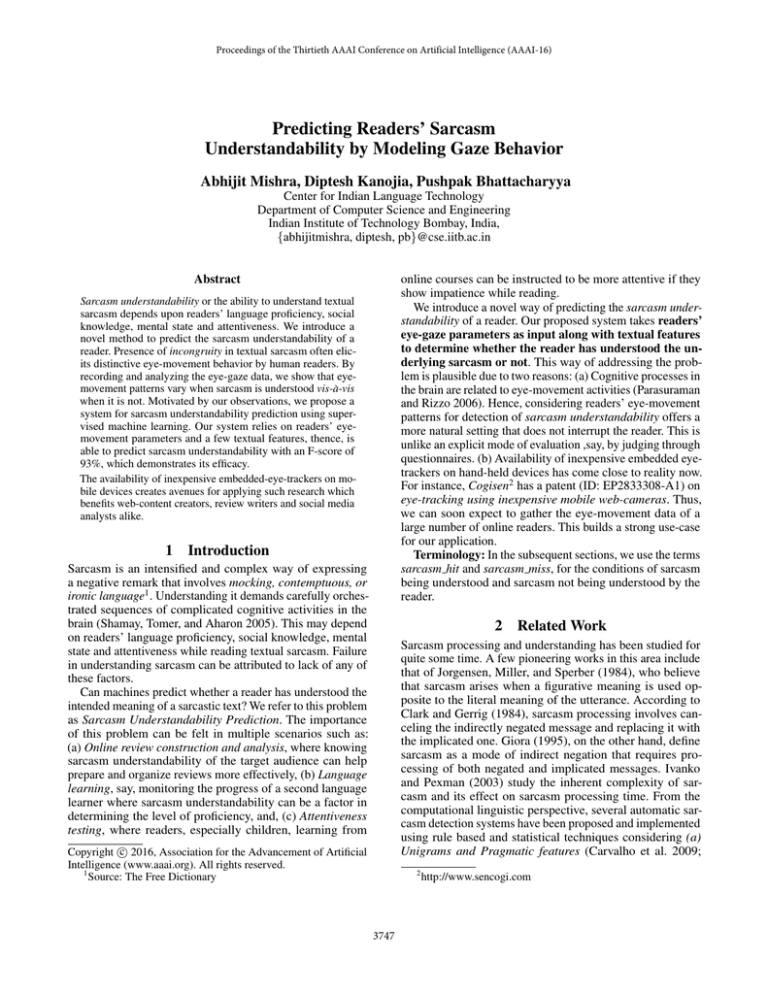
Proceedings of the Thirtieth AAAI Conference on Artificial Intelligence (AAAI-16)
Predicting Readers’ Sarcasm
Understandability by Modeling Gaze Behavior
Abhijit Mishra, Diptesh Kanojia, Pushpak Bhattacharyya
Center for Indian Language Technology
Department of Computer Science and Engineering
Indian Institute of Technology Bombay, India,
{abhijitmishra, diptesh, pb}@cse.iitb.ac.in
online courses can be instructed to be more attentive if they
show impatience while reading.
We introduce a novel way of predicting the sarcasm understandability of a reader. Our proposed system takes readers’
eye-gaze parameters as input along with textual features
to determine whether the reader has understood the underlying sarcasm or not. This way of addressing the problem is plausible due to two reasons: (a) Cognitive processes in
the brain are related to eye-movement activities (Parasuraman
and Rizzo 2006). Hence, considering readers’ eye-movement
patterns for detection of sarcasm understandability offers a
more natural setting that does not interrupt the reader. This is
unlike an explicit mode of evaluation ,say, by judging through
questionnaires. (b) Availability of inexpensive embedded eyetrackers on hand-held devices has come close to reality now.
For instance, Cogisen2 has a patent (ID: EP2833308-A1) on
eye-tracking using inexpensive mobile web-cameras. Thus,
we can soon expect to gather the eye-movement data of a
large number of online readers. This builds a strong use-case
for our application.
Terminology: In the subsequent sections, we use the terms
sarcasm hit and sarcasm miss, for the conditions of sarcasm
being understood and sarcasm not being understood by the
reader.
Abstract
Sarcasm understandability or the ability to understand textual
sarcasm depends upon readers’ language proficiency, social
knowledge, mental state and attentiveness. We introduce a
novel method to predict the sarcasm understandability of a
reader. Presence of incongruity in textual sarcasm often elicits distinctive eye-movement behavior by human readers. By
recording and analyzing the eye-gaze data, we show that eyemovement patterns vary when sarcasm is understood vis-à-vis
when it is not. Motivated by our observations, we propose a
system for sarcasm understandability prediction using supervised machine learning. Our system relies on readers’ eyemovement parameters and a few textual features, thence, is
able to predict sarcasm understandability with an F-score of
93%, which demonstrates its efficacy.
The availability of inexpensive embedded-eye-trackers on mobile devices creates avenues for applying such research which
benefits web-content creators, review writers and social media
analysts alike.
1
Introduction
Sarcasm is an intensified and complex way of expressing
a negative remark that involves mocking, contemptuous, or
ironic language1 . Understanding it demands carefully orchestrated sequences of complicated cognitive activities in the
brain (Shamay, Tomer, and Aharon 2005). This may depend
on readers’ language proficiency, social knowledge, mental
state and attentiveness while reading textual sarcasm. Failure
in understanding sarcasm can be attributed to lack of any of
these factors.
Can machines predict whether a reader has understood the
intended meaning of a sarcastic text? We refer to this problem
as Sarcasm Understandability Prediction. The importance
of this problem can be felt in multiple scenarios such as:
(a) Online review construction and analysis, where knowing
sarcasm understandability of the target audience can help
prepare and organize reviews more effectively, (b) Language
learning, say, monitoring the progress of a second language
learner where sarcasm understandability can be a factor in
determining the level of proficiency, and, (c) Attentiveness
testing, where readers, especially children, learning from
2
Related Work
Sarcasm processing and understanding has been studied for
quite some time. A few pioneering works in this area include
that of Jorgensen, Miller, and Sperber (1984), who believe
that sarcasm arises when a figurative meaning is used opposite to the literal meaning of the utterance. According to
Clark and Gerrig (1984), sarcasm processing involves canceling the indirectly negated message and replacing it with
the implicated one. Giora (1995), on the other hand, define
sarcasm as a mode of indirect negation that requires processing of both negated and implicated messages. Ivanko
and Pexman (2003) study the inherent complexity of sarcasm and its effect on sarcasm processing time. From the
computational linguistic perspective, several automatic sarcasm detection systems have been proposed and implemented
using rule based and statistical techniques considering (a)
Unigrams and Pragmatic features (Carvalho et al. 2009;
c 2016, Association for the Advancement of Artificial
Copyright Intelligence (www.aaai.org). All rights reserved.
1
Source: The Free Dictionary
2
3747
http://www.sencogi.com
González-Ibánez, Muresan, and Wacholder 2011; Barbieri, Saggion, and Ronzano 2014; Joshi, Sharma, and Bhattacharyya 2015) (b) Stylistic patterns (Davidov, Tsur, and
Rappoport 2010; Riloff et al. 2013) (c) Tweet hashtag interpretations (Liebrecht, Kunneman, and van den Bosch 2013;
Maynard and Greenwood 2014). Under different settings, the
best accuracies (in terms of F-score) of these systems vary
between 60% to 90%.
With the advent of sophisticated eye-trackers and
electro/magneto-encephalographic (EEG/MEG) devices, it
has been possible to delve deep into the cognitive underpinnings of sarcasm understanding. Shamay, Tomer, and Aharon
(2005) perform a neuroanatomical analysis of sarcasm understanding by observing the performance of participants with
focal lesions on tasks that required understanding of sarcasm
and social cognition. Camblin, Gordon, and Swaab (2007)
show that in multi-sentence passages, discourse congruence
has robust effects on eye movements. This also implies that
disrupted processing occurs for discourse incongruent words,
even though they are perfectly congruous at the sentence
level. Filik (2014), using a series of eye-tracking and EEG
experiments, find that, for unfamiliar ironies, the literal interpretation would be computed first, and a mismatch with
context would lead to a re-interpretation of the statement as
being ironic.
Reading researchers have applied eye-tracking for behavioral studies as surveyed and summarized by Rayner (1998).
But, from a computational perspective, there are less number
of works that quantify or predict various levels of difficulties
associated with reading comprehension and text understanding ability. Martınez-Gómez and Aizawa (2013) quantify
reading difficulty using readers’ eye-gaze patterns with the
help of Bayesian Learning. Mishra, Bhattacharyya, and Carl
(2013) propose a framework to predict difficulty in text translation using translator’s eye-gaze patterns with the help of
supervised machine learning approach. Similarly, Joshi et al.
(2014) introduce a system for measuring the difficulties perceived by humans in understanding the sentiment expressed
in texts.
Our method of analyzing eye-movement data for sarcasm
understandability is the first of its kind and is inspired by
these recent advancements.
3
movement patterns may be observed in the case of successful
processing of sarcasm, in contrast to an unsuccessful attempt.
This hypothesis forms the crux of our analysis and we
aim to prove/disprove this by creating and analyzing an eyemovement database for sarcasm reading. Our database can
be freely downloaded3 for academic purposes.
4
Creation of Eye-movement Database
The experimental setup for the collection of eye-movement
database is described below.
4.1
Document Description
We prepared a database of 1,000 short-text, comprising 10-40
words and one or two sentences. Out of these texts, 350 are
sarcastic and were collected as follows: (a) 103 sentences
were manually extracted from two popular sarcastic quote
websites4 , (b) 76 sarcastic short movie reviews were manually extracted from the Amazon Movie Corpus (Pang and
Lee ) and (c) 171 tweets were downloaded using the hashtag #sarcasm from Twitter. The 650 non-sarcastic texts were
either downloaded from Twitter or extracted from the Amazon Movie Review corpus. The sentences do not contain
highly topic/culture/country specific phrases. The tweets were
normalized to avoid difficulty in interpreting social media
lingo. All the sentences in our dataset carry either positive
or negative opinion about specific “aspects”. For example,
the sentence “The movie is extremely well cast” has positive
sentiment about the aspect “cast”.
Two expert linguists validated with 100% agreement that
the 350 sentences extracted from various sources are indeed
sarcastic and express negative sentiment towards the main
aspect. This forms the ground truth for our experiment.
4.2
Participant Description
We chose seven graduate students with science and engineering background in the age group of 22-27 years with
English as the primary language of academic instruction. Our
participants are non-native speakers of English. We confirm
that their native languages are read from left-to-right. This
eliminates the possibility of our experiment getting affected
by reading direction.
To ensure that they possess excellent level of proficiency in
English, our participants are selected based on their ToEFLiBT scores of 100 or above. They are given a set of instructions beforehand, that mention the nature of the task, annotation input method, and necessity of head movement minimization during the experiment. Participants were financially
rewarded for their effort.
Though our analysis is based on the current observations
involving non-native speakers (with acceptable English proficiency), our predictive framework is data driven and does not
rely heavily on any assumption about the nature of the eyemovement patterns. Additionally, we have used linguistic and
readability related features to ensure that, the combination
Sarcasm, Cognition and Eye-movement
Sarcasm often emanates from context incongruity (Campbell
and Katz 2012), which, possibly, surprises the reader and
enforces a re-analysis of the text. The time taken to understand sarcasm (referred to as the Sarcasm Processing Time)
depends on the degree of context incongruity between the
statement and the context (Ivanko and Pexman 2003). In the
absence of any information regarding the nature of the forthcoming text, intuitively, human brain would start processing
the text in a sequential manner, with the aim of comprehending the literal meaning. When incongruity is perceived, the
brain may initiate a re-analysis to reason out such disparity
(Kutas and Hillyard 1980) . As information during reading
is passed to brain through eyes, incongruity may affect the
way eye-gaze moves through the text. Hence, distinctive eye-
3
http://www.cfilt.iitb.ac.in/cognitive-nlp/
http://www.sarcasmsociety.com, http://www.themarysue.com/
funny-amazon-reviews
4
3748
P1
P2
P3
P4
P5
P6
P7
All
Acc.
79.71
89.14
87.14
88
72.57
90.29
85.71
IAA
0.71
0.77
0.75
0.76
0.65
0.77
0.75
Quote
Acc.
IAA
81.73
0.72
83.65
0.74
86.54
0.75
87.5
0.77
78.85
0.70
85.58
0.75
81.73
0.73
Twitter
Acc.
IAA
76.74
0.69
90.12
0.80
88.37
0.76
88.37
0.77
67.44
0.62
95.35
0.81
87.79
0.77
agreement between consensus and gold annotations is 98%,
ensuring the sanctity of the gold data). This shows the inherent difficulty of sarcasm understanding. Table 1 shows
the annotation accuracy of the seven participants along with
the average Inter Annotator Agreement of each participant
(P1-P7) with others, separately shown for the whole dataset
and individual domains. The incorrectness in annotation can
be attributed to: (a) Lack of patience/attention while reading,
(b) Issues related to text comprehension and understandability, and (c) Confusion/indecisiveness caused due to lack of
context.
Our objective is to find out if a reader has understood
sarcasm or not. How can polarity annotation help here? We
assume that if the reader does not understand sarcasm, the
text will be annotated with an incorrect polarity label. Our
whole analysis relies on this key-assumption.
Movie
Acc.
IAA
81.58
0.87
92.11
0.76
82.89
0.71
85.53
0.74
73.68
0.64
82.89
0.72
84.21
0.73
Table 1: Annotation results for seven participants. Acc. →
Percentage of sarcastic sentences correctly identified. IAA →
Average Cohen’s Kappa Inter Annotator Agreement between
a participant and others
of eye-gaze and linguistic/readability parameters will be able
to discriminate between sarcasm hit and sarcasm miss cases.
So, our approach is expected to work for a general population
of both native and non-native speakers.
4.3
5
Analysis of Eye-movement Data
To show the dependencies between reader’s eye movement
patterns and sarcasm understandability, we perform a twofold analysis of the eye-movement data intending to observe:
(a) Variation in eye-gaze attributes and (b) Variation in scanpaths.
Task Description
The task assigned to our participants is to read one sentence
at a time and annotate with binary sentiment polarity labels
(i.e., positive/negative). Note that we do not instruct our participants to explicitly annotate whether a sentence is sarcastic
or not. It has been shown by Gibbs (1986) that processing
incongruity becomes relatively easier if sarcasm is expected
beforehand. But, in practice, it seldom occurs that a reader
has prior knowledge about the nature of the forthcoming
text. Our setup ensures “ecological validity” in two ways. (1)
Readers are not given any clue that they have to treat sarcasm
with special attention. This is done by setting the task to polarity annotation (instead of sarcasm detection). (2) Sarcastic
sentences are mixed with non sarcastic text, which does not
give prior knowledge about whether the forthcoming text will
be sarcastic or not.
The eye-tracking experiment is conducted by following the
standard norms in eye-movement research (Holmqvist et al.
2011). At a time, one sentence is displayed to the reader along
with the “aspect” with respect to which the annotation has to
be provided. While reading, an SR-Research Eyelink-1000
eye-tracker (monocular remote mode, sampling rate 500Hz)
records several eye-movement parameters like gaze-fixations
(i.e., a long stay of gaze), saccade (i.e., quick jumping of
gaze between two positions of rest) and pupil size. The whole
experiment is divided into 20 sessions, each having 50 sentences to be read and annotated. This is to prevent fatigue
over a period of time. However, there was no time limit on
individual sentence annotations.
For our analysis, we consider only the 350 sarcastic sentences in our data-set, since our system requires the sentences
to be sarcastic. We acknowledge that the analysis of understandability of other linguistically complex forms of text
could be carried out using the rest of the 650 sentences. This
is, however, beyond the scope of this work.
Even though we took all the necessary measures to control the experiment, the individual annotation accuracy for
our participants is still far from being 100%. (However, the
5.1
Variation in Eye-gaze Attributes
Eye-movement patterns are characterized by two basic attributes: (1) Fixations, corresponding to a longer stay of gaze
on a visual object (like characters, words etc. in text) (2) Saccades, corresponding to the transition of eyes between two
fixations. Moreover, a saccade is called a Regressive Saccade
or simply, Regression if it represents a phenomenon of going
back to a pre-visited segment. A portion of a text is said to
be skipped if it does not have any fixation.
We perform a series of t-tests5 to check if there is a statistically significant difference between the distributions of various gaze attributes across all participants for the conditions
of sarcasm miss and sarcasm hit. We consider four basic
gaze attributes, viz., (1) Average fixation duration per word
(2) Average count of fixations per word (3) Total regression
counts per word and (4) Percentage of words skipped. These
attributes are taken from reading literature for behavioral
studies (Rayner 1998). The null hypothesis for each gaze
attribute is: There should not be any significant difference
between the mean (μ) of the attribute for both sarcasm miss
and sarcasm hit. The threshold α for accepting or rejecting
the null hypothesis is set to 0.05. The test results are shown
in Table 2. Except for average count of fixations, all other attributes exhibit significant differences, with fixation duration
having the highest difference.
It is evident from the tests that the average time spent
(in terms of fixation duration) is generally higher for sarcasm miss than for sarcasm hit. For both fixation duration
and regressive saccade count, we consistently observe a
higher variance for sarcasm miss. This observation can be
intuitively felt by considering the following scenarios: (a)
When sarcasm is not understood because of lack of attentiveness, the reader may spend less time/focus on different
5
3749
two-tailed assuming unequal variance
Gaze-Attribute
Fixation Duration (in ms)
Average Count of Fixations
Count of Regressive Saccades
Word Skip Percentage
μsarcasm miss
357
0.79
6
28.6
σsarcasm miss
229
0.2
5
14.6
μsarcasm hit
307
0.77
3.2
30.1
σsarcasm hit
176
0.18
2.79
15.1
t
3.8
1.89
2.27
-2.06
p
0.00017
0.05
0.01
0.03
Remark
Significant
Not significant
Significant
Significant
Table 2: T-test statistics for different eye-movement attributes for the conditions of (i) sarcasm miss and (ii) sarcasm hit
5.2
Scanpaths are line-graphs that contain fixations as nodes
and saccades as edges; the radii of the nodes represent the
duration of fixations. Figure 1 presents scanpaths of four
participants from our experiment for three sarcastic sentences
S1, S2 and S3. The x-axis of the graph represents the sequence
of words a reader reads, and the y-axis represents a temporal
sequence in which the fixations occur.
Consider a sarcastic text containing incongruous phrases
A and B. Our general observation of scanpaths reveals the
following: In most of the cases, a regression is observed
when a reader starts reading B after skimming through A.
On the other hand, if the reader slowly and carefully reads
A, the fixation duration on B is significantly higher than the
average fixation duration per word. A scanpath that does not
exhibit one of the above mentioned properties indicates that
the underlying incongruity (and hence, sarcasm) may not
have been realized by the reader.
Figure 1 depicts two distinct cases through three example scanpaths, where differences in scanpaths are observed
for sarcasm miss and sarcasm hit. The cases are explained
below:
!"
Variation in Scanpaths
Figure 1: Scanpaths of four different sets of participants for
three sarcastic sentences S1, S2 and S3. The circles represent
fixations, edges represent saccades and areas of the circle represent fixation duration. X- and Y- axes respectively represent
the positions of words in the sentence and temporal sequence
in which the fixations occur. Scanpaths of participants who
have not identified sarcasm correctly (PIncorrect ) are shown
in red.
1. Case 1. Lack of attention: Consider sentence S1. When
sarcasm is identified successfully, we see at least one regression from the phrase “original misconception” to the
phrase “always cherish”. On the other hand, participant
PIncorrect have spent relatively smaller amount of time on
these phrases. We do not observe any regressive saccade
between the two incongruous phrases.
segments of the text. Moreover, more words may be skipped
and the number of regressive saccades will be less. (b) When
sarcasm is not understood because of lack of linguistic expertise, conceptual knowledge or cognitive ability, the reader
may spend fixate more on different segments. The skipping
rate will be low and the reader’s eye may re-visit various
segments from time to time, perhaps, to gather more clues for
interpreting the text. Hence, more regressive saccades may
be observed.
2. Case 2. Lack of realization of underlying incongruity:
Consider sentences S2 and S3. For sentence S2, participant
PIncorrect focuses on the portion of the text containing
positive sentiment. This indicates that the participant may
have formed a bias towards the sentiment of the sentence
being positive, thereby, not realizing the underlying incongruity. For sentence S3, participant PIncorrect spends more
amount of time on the phrase “cheesy commercialism”.
The “negative intent” (and hence, the incongruity) of this
phrase may not have been realized.
Note that our observations of variations in different gaze
attributes may not be confined to the presence of sarcasm. For
example, a garden-path sentence like “The horse raced past
the barn fell” may enforce the brain to perform a syntactic
reanalysis of the text. This may affect gaze-fixations and
regressions (Malsburg and Vasishth 2011) the same way as
sarcasm does. But, we rule out such cases as our objective is
to predict understandability for sarcastic texts.
Though it is quite difficult to arrive at a conclusion regarding how sarcasm understandability is captured in scanpaths,
our analysis gives us motivation to exploit properties from
the eye-movement patterns to build systems for the task of
sarcasm understandability prediction.
5.3
We extend our analysis to gain more insight into the eyemovement behavior, and its relation with sarcasm understandability by considering scanpaths.
A Note on Complexity of Sarcasm
The complexity of sarcasm is not same across all texts. The
underlying incongruity of sarcasm may either be Explicit,
3750
Category
Textual
Features
Gaze
Based
Features
Feature Name
Interjections (IJT)
Punctuations (PUNC)
Discourse Connectors (DC)
Explicit Incongruity (EXP)
Largest Pos/Neg Subsequence (LAR)
Positive words (+VE)
Negative words (-VE)
Readability (RED)
Number of Words (LEN)
Avg. Fixation Duration (FDUR)
Avg. Fixation Count (FC)
Avg. Saccade Length (SL)
Type
Integer
Real
Real
Integer
Integer
Integer
Integer
Real
Integer
Real
Real
Real
Regression Count (REG)
Skip count (SKIP)
First part fixation duration (F1DUR)
Second part fixation duration (F2DUR)
Count of regressions from second half to
first half of the sentence (RSF)
Real
Real
Real
Real
Real
Largest Regression Position (LREG)
Real
Scanpath Complexity (SPC)
Real
Intent
Count of interjections
Count of punctuation marks
Count of discourse connectors
Number of times a word follows a word of opposite polarity
Length of the largest series of words with polarities unchanged
Number of positive words
Number of negative words
Flesch Readability Ease of the sentence (Kincaid et al. 1975)
Number of words in the sentence
Sum of fixation duration divided by word count
Sum of fixation counts divided by word count
Sum of saccade lengths (number of words travelled during saccade
movements) divided by word count
Total number of gaze regressions
Number of words skipped divided by total word count
Average duration of fixation on the first half of the sentence.
Average duration of fixation on the second half of the sentence.
Number of regressions from second half of the sentence to the first
half of the sentence (given the sentence is divided into two equal
half of words)
Ratio of the absolute position of the word from which a regression
with the largest amplitude (number of pixels) is observed, to the
total word count of sentence
Product of Average fixation duration, Average saccade length and
Average regression count
Table 3: Features for Sarcasm Understandability Prediction
features are computed using in-house lexicons of interjections, discourse connectors, MPQA lexicon6 and NLTK7 .
The feature-set is discussed in Table 3.
where a positive sentiment phrase is followed by a negative
sentiment phrase, (as in “I love being ignored”) or Implicit,
where a positive sentiment phrase is followed by a negative
situation that may not contain any sentiment bearing word
(as in “ It’s an all star salute to Disney’s cheesy commercialism”) (Joshi, Sharma, and Bhattacharyya 2015). Moreover, the cognitive load associated with sarcasm processing
depends on the degree of context incongruity between the
statement and the context (Ivanko and Pexman 2003). Intuitively, scanpaths of readers also vary according to the type
and the degree of incongruity in the text. Hence, a framework
designed for sarcasm understandability prediction has to be
aware of the type and degree of context incongruity in the
sarcastic text, along with the eye-gaze attributes. Our feature
design takes these aspects into consideration.
6
6.1
Applying Multi-instance Classification
For each of the 350 sarcastic sentences, eye-movement data
from multiple annotators are available. Instead of considering individual data for each sentence as a single example, we
choose Multi Instance Learning for classification. Multiinstance (MI) learning differs from standard supervised learning in a way that each example is not just a single instance:
examples are collections of instances, called bags. In our
case, all of these bags correspond to one sentence and the
instances of each bag correspond to gaze and textual features
derived for each participant. Textual features are repeated
for each instance in a bag. We apply Multi-instance Logistic Regression (MILR) (Xu and Frank 2004) implemented
using the Weka API (Hall et al. 2009) under the standard
multi instance assumption. After transforming our dataset to
a multi-instance dataset, we performed a 5-fold cross validation8 . Each fold has a train-test split of 80%-20% and each
split contains examples from all seven participants. The train
splits contain multiple instances per example whereas test
splits contain one instance per example. This emulates a real
life situation where our system would need to predict sarcasm
Predicting Sarcasm Understandability
Our framework for sarcasm understandability prediction is
based on supervised learning, i.e., it learns a predictive model
on training data and a set of features (i.e. properties of
each example of the training data). Our dataset contains
350 sarcastic sentences, each annotated by 7 participants.
This amounts to a total of 2450 examples for which both
eye-movement data and sarcasm understandability labels
are available (discussed in section 4). From these, 48 instances are discarded due to poor quality of recorded eyegaze patterns. Our feature-set comprises (i) Textual features, that capture the degree of incongruity of sarcastic
text (taken from (Joshi, Sharma, and Bhattacharyya 2015;
Riloff et al. 2013)) and (ii) Gaze features, that relate to sarcasm understandability (discussed in Section 5.1). Textual
6
http://mpqa.cs.pitt.edu/lexicons/subj lexicon/
http://www.nltk.org/
8
The system performs badly, as expected, in a Non-MI setting.
The F-scores for SVM and Logistic Regression classifiers are as
low as 30%. Hence, they are not reported here.
7
3751
Class
sarcasm miss
sarcasm hit
Weighted Avg.
Kappa
R
F
P
R
F
P
R
F
Avg.
Baseline1: Classification based on class frequency
16.1 15.5 15.7 86.5 87
86.7 85.9 86.71 86.3 0.014
Baseline2: MILR Classifier considering time taken to read + textual features
23.6 86.9 78.2 11.5 94.1 82.7 15.4 90.4
80
0.0707
Our approach: MILR Classifier considering only gaze features
82.6 36
50
89.9 98.7 94.1 88.8 89.4
87.5 0.4517
Our approach: MILR Classifier considering gaze + textual features
68.1 47.5 56.0 91.8 96.3 94.0 88.4 89.4
88.6 0.5016
42.9 36.6 39.5 88.6 91.0 89.8 81.4 82.5
81.9 0.293
63.0 61.7 62.4 94.4 94.7 94.6 90.4 90.5
90.5 0.5695
87.8 61
72
94.1 98.6 96.3 93.2 93.5
93
0.6845
P
All
All
All
Quote
Movie
Twitter
All
Table 4: Classification results for sarcasm understandability prediction. P→ Precision, R→ Recall, F→ F˙score, Kappa→ Kappa
statistics showing agreement of the predicted labels with the gold labels
0.6
90
Avg. Kappa
Avg. F-Score
.
85
80
sifiers by considerable margins. Our system achieves an Fscore of 72% for sarcasm miss class and an overall F-score
of 93%. The domain-wise performance is much less than
that on the mixed domain data-set. It is difficult to explain
why the performance of our system on certain domain is
better/worse than others, given that systems for individual
domains are left with small amounts of training data.
It is interesting to note that by considering the gaze features
alone, the system still performs with reasonable accuracy,
indicating that sarcasm understandability, the way we define
it, is indeed an attribute of the reader. However, we notice that
while precision is high (82.6%) for the sarcasm miss class,
the recall is quite low (36%). We speculate that, readers’ eyemovement patterns may have been affected by other forms
of linguistic complexities (like word difficulty, word sense
ambiguity etc.). In the absence of the textual features (like
readability) that help handle such complexities to some extent,
some of the instances of sarcasm miss are misclassified as
sarcasm hit, thereby, reducing the recall for sarcasm miss
class.
To see the impact of training data size on the classification results, we create a stratified random train-test split of
80%:20%. We train our classifier with 100%, 90%, 80% and
70% of the training data. The F-scores and Kappa statistics
on the test set for various training data sizes are shown in
Figure 2. The trend of F-score indicates that adding more
data may increase the accuracy of our system.
We analyze the importance of our features by ranking
them based on their weights learned by Multi-instance Logistic Regression. As shown in Figure 3, the negative and
positive values of the features indicate their support towards
sarcasm hit and sarcasm miss classes. The y-axis values
show the weights of the features, indicating their predictive
power. We observe that average skip has the maximum predictive power followed by scanpath complexity.
0.5
0.4
40 60 80 100
Training data %
40 60 80 100
Training data %
0
RSF
LREG
F2DUR
F1DUR
SPC
SKIP
SL
REG
FC
RED
FDUR
DC
LEN
IJT
PUNC
-VE
EXP
+VE
−5
LAR
Feature weights
Figure 2: Effect of training data size on classification accuracy in terms of F-score (a) and Kappa statistics (b).
Features
Figure 3: Significance of features as observed by the weights
of the MILR classifier
understandability for any new sarcastic sentence for a new
instance of reading.
In the absence of any existing system to compare our results with, we propose two baselines- (a) Baseline1: A classifier that generates predictions by respecting the training
sets class distribution and (b) Baseline2: An MILR based
classifier that considers the average time taken by the reader
along with other textual features for prediction. Please note
that average time taken by the reader has not been taken as a
feature in our best reported system due to its negative effect
on the overall accuracy.
The results of our classification are shown in Table 4 for the
whole data-set and individual domains (viz., Quotes, Movie
and Twitter). Our best system outperforms the baseline clas-
6.2
Error Analysis
The classification error could be attributed to a number of
factors. First, our data-set is highly class imbalanced as cases
of sarcasm miss are significantly less than that of sarcasm hit
(with a class ratio of 1:8). This affects the learning of our
classifier. Errors may have been introduced in feature extrac-
3752
tion due to limitations of the NLP tools and errors committed
by the eye-tracking hardware.
7
Hall, M.; Frank, E.; Holmes, G.; Pfahringer, B.; Reutemann, P.; and
Witten, I. H. 2009. The weka data mining software: an update.
ACM SIGKDD explorations newsletter.
Holmqvist, K.; Nyström, M.; Andersson, R.; Dewhurst, R.; Jarodzka, H.; and Van de Weijer, J. 2011. Eye tracking: A comprehensive
guide to methods and measures. Oxford University Press.
Ivanko, S. L., and Pexman, P. M. 2003. Context incongruity and
irony processing. Discourse Processes 35(3):241–279.
Jorgensen, J.; Miller, G. A.; and Sperber, D. 1984. Test of the
mention theory of irony. Journal of Experimental Psychology:
General 113(1):112.
Joshi, A.; Mishra, A.; Senthamilselvan, N.; and Bhattacharyya, P.
2014. Measuring sentiment annotation complexity of text. In
Association of Computational Linguistics (Daniel Marcu 22 June
2014 to 27 June 2014). Association for Computational Linguistics.
Joshi, A.; Sharma, V.; and Bhattacharyya, P. 2015. Harnessing
context incongruity for sarcasm detection. Proceedings of 53rd
Annual Meeting of the Association for Computational Linguistics,
Beijing, China 757.
Kincaid, J. P.; Fishburne Jr, R. P.; Rogers, R. L.; and Chissom, B. S.
1975. Derivation of new readability formulas (automated readability
index, fog count and flesch reading ease formula) for navy enlisted
personnel. Technical report, DTIC Document.
Kutas, M., and Hillyard, S. A. 1980. Reading senseless sentences: Brain potentials reflect semantic incongruity. Science
207(4427):203–205.
Liebrecht, C.; Kunneman, F.; and van den Bosch, A. 2013. The
perfect solution for detecting sarcasm in tweets# not. WASSA 2013
29.
Malsburg, T., and Vasishth, S. 2011. What is the scanpath signature of syntactic reanalysis? Journal of Memory and Language
65(2):109–127.
Martınez-Gómez, P., and Aizawa, A. 2013. Diagnosing causes of
reading difficulty using bayesian networks.
Maynard, D., and Greenwood, M. A. 2014. Who cares about
sarcastic tweets? investigating the impact of sarcasm on sentiment
analysis. In Proceedings of LREC.
Mishra, A.; Bhattacharyya, P.; and Carl, M. 2013. Automatically
predicting sentence translation difficulty. In Proceedings of the 51st
Annual Conference of Association for Computational Linguistics
(ACL), Sofia, Bulgaria.
Pang, B., and Lee, L. A sentimental education: Sentiment analysis using subjectivity summarization based on minimum cuts. In
Proceedings of the 42nd annual meeting on Association for Computational Linguistics.
Parasuraman, R., and Rizzo, M. 2006. Neuroergonomics: The brain
at work. Oxford University Press.
Rayner, K. 1998. Eye movements in reading and information
processing: 20 years of research. Psychological bulletin 124(3):372.
Riloff, E.; Qadir, A.; Surve, P.; De Silva, L.; Gilbert, N.; and Huang,
R. 2013. Sarcasm as contrast between a positive sentiment and
negative situation. In Proceedings of Empirical Methods in Natural
Language Processing, 704–714.
Shamay, S.; Tomer, R.; and Aharon, J. 2005. The neuroanatomical basis of understanding sarcasm and its relationship to social
cognition. Neuropsychology 19(3):288.
Xu, X., and Frank, E. 2004. Logistic regression and boosting for
labeled bags of instances. In Advances in knowledge discovery and
data mining. Springer. 272–281.
Conclusion and Future Work
As far as we know, our work of predicting readers’ sarcasm
understandability is the first of its kind. We have tried to
establish the relationship between sarcasm understandability
and readers’ eye movement patterns and proposed a predictive framework based on this observation. Our immediate
future plan is to gather more training data, include more
insightful features and explore additional techniques to address class-imbalance problem more efficiently. Since the
motivation of this work comes from the increasing usage of
eye-trackers in hand-held gadgets, we aim to check the usefulness of our technique on a much larger data-set, collected
using mobile eye-trackers. Moreover, instead of considering
sarcasm understandability as a two class problem, we plan
to work towards building a framework that gives real valued
scores for sarcasm understandability, indicating to what extent sarcasm has been understood. Our overall observation is
that cognition cognizant techniques involving eye-tracking
look promising for sarcasm understandability prediction.
Acknowledgment: We thank the members of CFILT Lab
and the students of IIT Bombay for their help and support.
References
Barbieri, F.; Saggion, H.; and Ronzano, F. 2014. Modelling sarcasm
in twitter, a novel approach. In Proceedings of the 5th WASSA,
Association for Computational Linguistics.
Camblin, C. C.; Gordon, P. C.; and Swaab, T. Y. 2007. The interplay
of discourse congruence and lexical association during sentence
processing: Evidence from {ERPs} and eye tracking. Journal of
Memory and Language 56(1):103 – 128.
Campbell, J. D., and Katz, A. N. 2012. Are there necessary conditions for inducing a sense of sarcastic irony? Discourse Processes
49(6):459–480.
Carvalho, P.; Sarmento, L.; Silva, M. J.; and De Oliveira, E. 2009.
Clues for detecting irony in user-generated contents: oh...!! it’s so
easy;-). In Proceedings of the 1st international CIKM workshop on
Topic-sentiment analysis for mass opinion, 53–56. ACM.
Clark, H. H., and Gerrig, R. J. 1984. On the pretense theory of irony.
Journal of Experimental Psychology: General 113(1):121–126.
Davidov, D.; Tsur, O.; and Rappoport, A. 2010. Semi-supervised
recognition of sarcastic sentences in twitter and amazon. In Proceedings of the Fourteenth CoNLL. Association for Computational
Linguistics.
Filik, Ruth; Leuthold, H. W. K. P. J. 2014. Testing theories of irony
processing using eye-tracking and erps. Journal of Experimental
Psychology: Learning, Memory, and Cognition.
Gibbs, R. W. 1986. Comprehension and memory for nonliteral utterances: The problem of sarcastic indirect requests. Acta Psychologica
62(1):41 – 57.
Giora, R. 1995. On irony and negation. Discourse processes
19(2):239–264.
González-Ibánez, R.; Muresan, S.; and Wacholder, N. 2011. Identifying sarcasm in twitter: a closer look. In Proceedings of the 49th
Annual Meeting of the Association for Computational Linguistics:
Human Language Technologies: short papers-Volume 2, 581–586.
Association for Computational Linguistics.
3753

